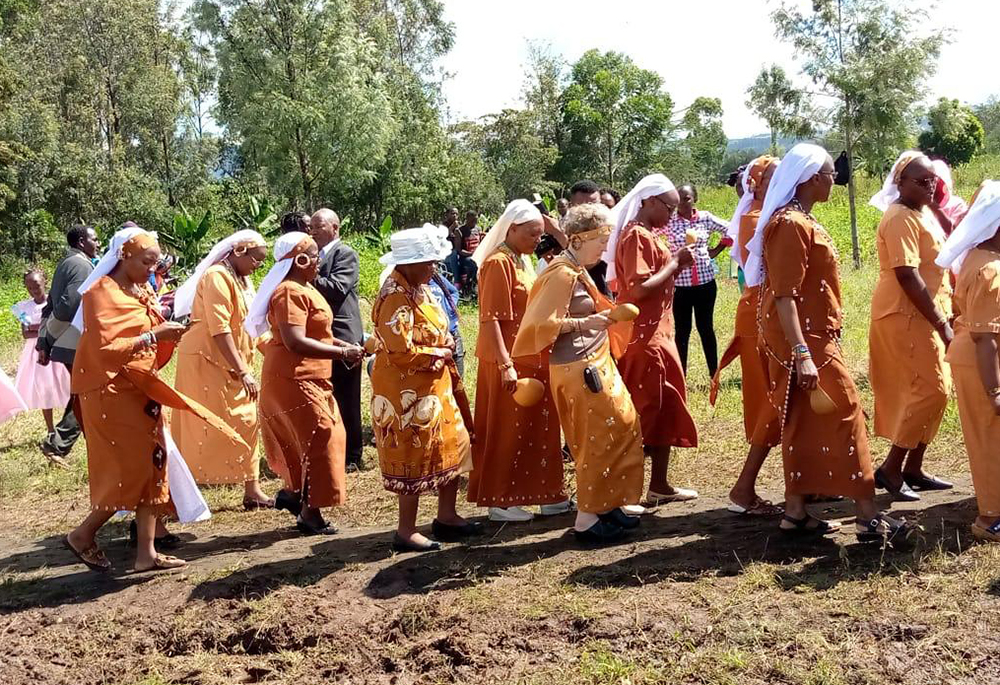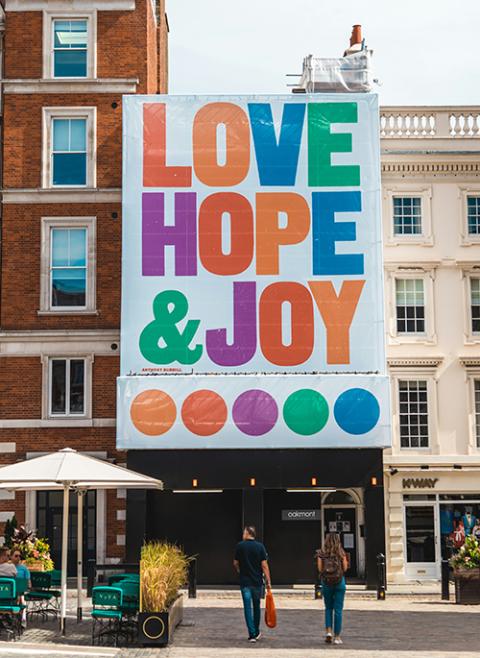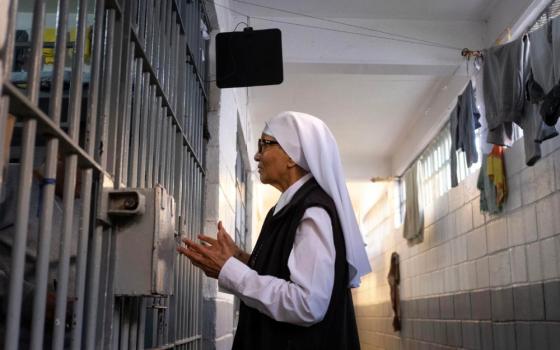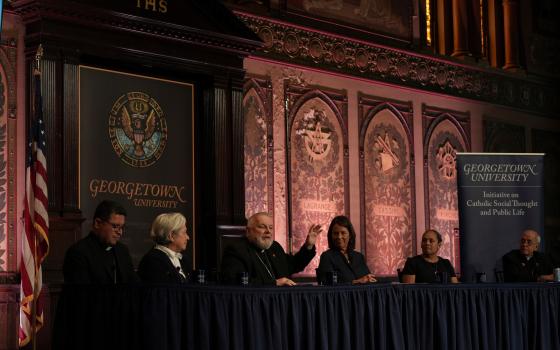
Sr. Joyce Meyer, in the center without a headpiece, joins sisters in Lusaka, Zambia, during a 2024 convening of sisters by the Conrad Hilton Foundation. (Courtesy of Joyce Meyer)
A friend of mine from Los Angeles had taken part in the June 14 "No Kings" protest, and she told me about one experience she had being in a group that brought a band to join the protest. The band inclusion had two goals: One was to keep the group spirit up, and the other was to counter groups wanting to disrupt the protest.
It was through this experience that she learned about "joy as resistance." I became intrigued with this idea and learned that in other cities around the country, similar groups were also blessed with music, dance or cartoon figures of those whose new policies were being protested.
But in my research, the article I found most fascinating was written by Ingrid Fetell Lee, "Joy Is An Act of Resistance: How Celebration Sustains Activism." As Lee unpacked this idea, I found myself recalling experiences in my own life that confirmed her words even beyond those who are actively engaged in activist work. I think it would be helpful for all of us these days in feeling disappointment, frustration and at times helplessness to keep in mind the importance of joy.
Lee begins by saying that these words about joy are not to encourage turning a blind eye to injustice, or to just give comfort, but instead to realize that intentional joyful activity can be a means to foster change. She describes six different ways how joy can sustain activism: Joy as a propulsive force, a creator of unity, a way to reclaim our humanity, a disruptor of expectations, a promoter of resilience, and an energy that inspires hope.

(Unsplash/Nicolas J Leclercq)
Joy as a propulsive force can mobilize people to action, as history illustrates. Joy was often experienced as a threat to autocratic powers. For example, she tells of China under Mao Zedong, in which music was banned during the revolution, making it criminal to listen to Beethoven. She also mentions Nazi Germany, which condemned Jewish music and forbade Jewish composers to perform. In Trinidad, during the 1800s, the British colonizers banned drumming, fearing it as a way of communication that would lead to revolution.
The drumming example recalled for me how in early years of colonization of African countries and the Native peoples of America, even the Catholic Church prohibited cultural rituals and music as a means of control.
In Africa, traditional drumming during liturgical celebrations was not allowed by Catholic missionaries. In North America, Native Americans were forbidden to practice some of their music and rituals, which were considered uncivilized and threatening.
Lee also reminded me of the Singing Revolution of Estonia between 1987 and 1991, which ultimately led to independence. Singers' heart rates synchronize, brain waves line up; music has the power to unite and, as she suggests, threatens the ability to control.
She quotes Audre Lorde's essay "The Uses of the Erotic": "In order to perpetuate itself, every oppression must corrupt or distort those various sources of power within the culture of the oppressed that can provide energy for change." Joy, Lee writes, "counters and contrasts with the rigidity and control of oppressive structures in a non-violent way."
Advertisement
I identified completely with her description of how dance creates community. In a number of African gatherings especially that I have been part of, we have danced with people not only from many different tribes, but also Europeans and Americans. The joy of dance is powerful and unifying, connecting people on a physical level. Connections can be perceived as threatening to oppressors, because, even as onlookers, connective energies can be experienced.
"Joy lets us reclaim our humanity," and individual joy can empower us to resistance, Lee writes. Oppression usually denies full humanity to those being oppressed through restriction, loss of agency, denigration or shaming of resources of pleasure. But, joy helps us reclaim agency, signals vibrancy and asserts freedom that refuses and resists dehumanization even in the most dehumanizing situations.
Lee gives an example of World War I soldiers cultivating gardens in their trenches, growing flowers to keep one another humanized. Justice, liberation and well-being are joyful states of being; pleasure and beauty help us maintain and achieve them.
One of her ideas spoke another important truth: "Joy is also a manifestation of abundance," a contrast to the language of oppression where a sense of scarcity engenders anxiety, fear and a focus on what is lacking. These feelings can blind us to our own potential and hope.
She gives the example of neglected schools in New York City that are usually colorless, functional places, located in neighborhoods that invite these negative attitudes of scarcity. To counteract this environment, she tells of Publicolor, an organization that paints those schools with vibrant colors reminding students that even though living in a place of outward scarcity, they are deserving of a joyful, beautiful life.
Lee's fourth description of the power of joy, after describing how it acts as restorer, unifier and propeller, is its power to also disrupt expectations and disarm, making something seemingly threatening, not so. She mentions "own-race face bias" — a new concept to me — referring to being able to distinguish differences in faces of our own race, but unable to do so with people of other races. Lee suggests that experiencing joy with the "other" can disrupt this bias.
I encountered this disruption in myself when I went to Zambia as a missionary and had never been in groups of people of color. I was teaching school and at first, could not recall individual students' names and faces: I primarily saw "color." As I got to know the women in class and joined in some of their joyful celebrations, I was able to "see." I could eventually even recognize when someone was pale from not feeling well or when students returned with sun tans from working in the fields during school breaks. Their dread of sun darkening was at first amusing to me until I, too, could tell the differences.
We all know from experience that lasting change is slow and laborious, and can lead to burnout from chronic stress that might not only be psychological, but also physical and spiritual. So, how is resilience maintained?
Lee suggests that along with essential rest, more is needed: release and celebration, not just for big wins, but those smaller victories along the way, too. Even small bursts of positive emotion can restore physically and emotionally. She also emphasizes that passive entertainment is not as restorative as sensual pleasures, such as turning to nature — to feast the eyes, smell the scents, touch the earth, and move the body. Nature can smooth anxiety and restore the ability to focus. As Lee writes:
Sensory joy is a form of care that contrasts with traumatic circumstances and helps cultivate the resilience needed to counter oppression.
Joy gives rise to hope, Lee writes, describing hope as "a form of emotional vision that stokes our motivation and fans the flames of change." And this vision of what is possible is nurtured by joy: finding joy in the present, being attentive to those special moments of joy we experience in our bodies and feelings, and being intentional to create them for ourselves and others.
Without it we lose sources of unity, strength and resilience to change the injustices in our world.





